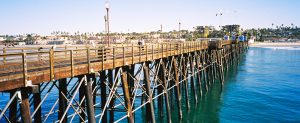
Given the length of the pier, the water out toward the end is fairly deep. That fact means that even though you may still encounter the fish found in the mid-pier area, the end area will offer up more of the pelagic species—Pacific mackerel, jack mackerel, sardines, bonito (some years), barracuda (today, usually a small pencil instead of a log), white seabass (usually small ones called seatrout), and, late summer to fall, an occasional yellowtail (typically a small, firecracker-size fish).
The end area is also were you typically will see salema (at night) and rock-frequenting species like small rockfish and sheephead (only during the day).
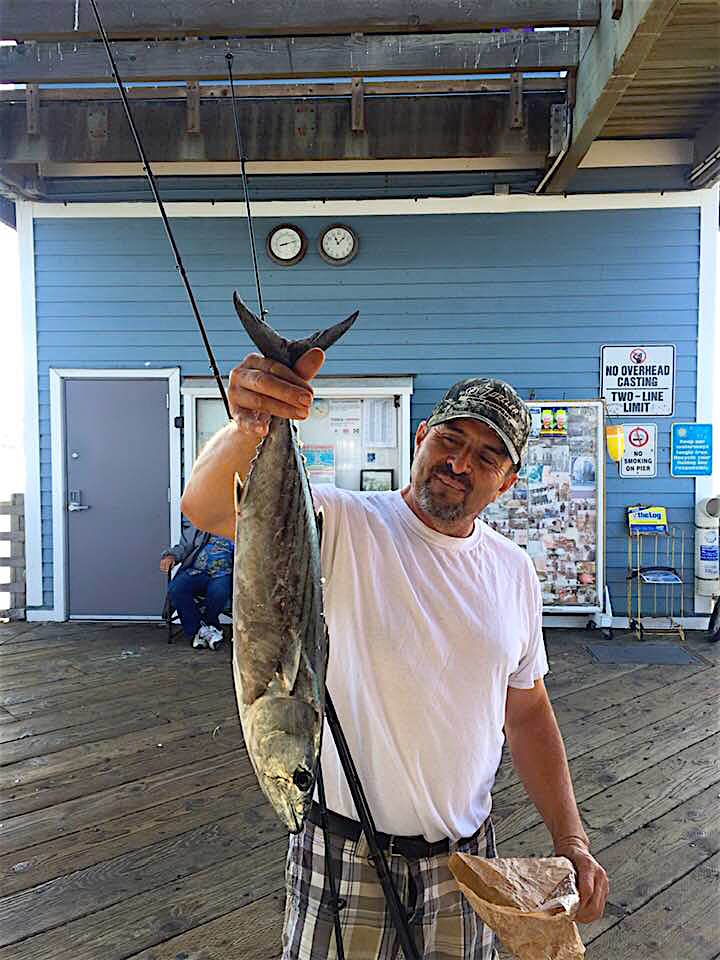
Bonito — 2018 (Picture courtesy of the Oceanside Pier Bait Shop)
Perhaps to be expected, this deeper-water area is often home to the largest sharays, both sharks and rays. Large leopard sharks and threshers lead the list but some big shovelnose sharks (guitarfish) will show up and sometimes huge bat rays.
If the fish aren’t biting just sit back and relax—or head down to the Ruby’s at the end of the pier and have a hamburger, fries and a milkshake. Watch the dolphins that seem to show up most days at the pier and, if it is wintertime, you might even see a grey whale migrating by the pier. The pier is a great spot to simply sit and enjoy the ocean.
Fishing Tips. As mentioned, the pier sees several different zones that contain somewhat different species. There are also zones as far as water depth with some fish being benthic in nature (bottom species), some preferring the mid-depth portions of the water, and some preferring the uppermost layers of water. There are also some species that feed on and usually hang close to the pilings. Adding to the mix are the seasons since some species move into and out of the pier waters dependent upon the time of the year.
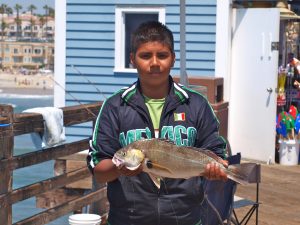
Good-sized spotfin croaker
A wise angler tries to answer the what, when, where and how questions. What species are being sought? When will those species be found at the pier? Where will the species be found? How is the best way to catch the fish if they are present? Success is never guaranteed but answering these questions will lead to greater success.
Inshore is the area preferred by many of the regulars, those who are on the pier almost daily and who are seeking out the larger spotfin and yellowfin croakers, corbina and barred surfperch. All of these species are benthic species that feed on organisms found on the bottom and all are caught fishing on the bottom.
Sand crabs are hard to beat for the corbina and perch but ghost shrimp, bloodworms, lugworms and fresh mussels are primo baits for all of these species—and more. I prefer a high/low set up with a torpedo sinker but many prefer a Carolina rigging; just remember to use fairly small hooks nothing bigger than a size 4 and if using ghost shrimp as bait use a Kahle or similar-type hook.
Best time for the barred surfperch is winter to spring while summer to fall is considered the prime time for yellowfin croaker, spotfin croaker and corbina. However, the bite can start early, especially if the water warms up. May of 2007 saw a run of large spotfins (some exceeding six pounds) with baby mussels being the irresistible bait.
Wintertime can also see big schools of walleye surfperch enter into the inshore and mid-pier areas. They are typically smaller than the barred surfperch but still fun to catch, they are also fairly easy to catch as long as you use small hooks. I prefer a couple of size 8 hooks on a high/low rigging but many people simply like to catch them using a Sabiki-type bait rig, one with smaller hooks. The walleye like to hang just off the bottom to mid-depth so the thing to do is to find the school. Drop your bait to the bottom and if you don’t feel any bites move up a foot or so, continue upward until you locate the school and then keep fishing in that area.
The shallow waters do yield a mix of rays, typically smaller round stingrays, thornback rays, and an occasional butterfly ray. All are caught on the bottom using cut bait—anchovies, mackerel, sardines, and squid but they may also decide to hit one of the baits placidly sitting on the bottom waiting for a croaker. High/low or Carolina riggings usually with a size 4 or larger hook.
Late winter/early spring months may see an influx of small leopard sharks into the shallows. Sometimes there are hundreds of the small sharks, few larger than 24 inches in length—and thus illegal. But, it can be hard to keep them off a baited hook. Just be sure to return them unharmed to the water.
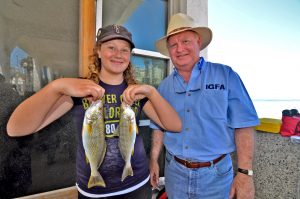
Yellowfin croaker taken at the 2011 UPSAC/IGFA Oceanside Pier Kids Fishing Derby
Mid-pier to the end can yield any of the inshore species but additional species should enter the catch. Benthic (bottom) species include a few yellowfin and spotfin croaker, sargo, China (black) croaker (generally at night) and some of the smaller croakers—queenfish (herring) and white croaker (tomcod). For the larger croakers and sargo use the same baits and techniques as mentioned in the inshore section.
White croaker will hit on a small strip of anchovy or mackerel as well as worms. Most people simply cast out and wait. Better still is to make a cast and then tighten your line as soon as it is cast. The white croaker will often follow the bait down to the bottom and start pecking at the bait as soon as it hits bottom. A slow and steady retrieve will often will allow you to feel the bite and often times will result in a fish on nearly every cast (if they’re in the area). Best rigging: a high/low rigging with size 6 hooks.
Queenfish are found mid-depth in large schools and will often strike on small strips of anchovy or mackerel jigged up and down in a slow manner using a high/low rigging with size 8 hooks. They can also be caught using a Lucky Lura or Sabiki-type bait rig with small hooks. Again drop the line a foot or so off the bottom and move it up until you feel fish hitting your bait (or being snagged on the bait rig). Unlike some species, a slow upward and down jigging motion seems best for the queenfish.
Mid-pier, but in mid-depth to surface water, will see jacksmelt and topsmelt. Wintertime is the prime time for the larger jacksmelt and many of the croaker regulars will switch to jacksmelt for these cooler months. The smelt (actually silversides) can be caught on bait rigs or (as I prefer) a high/low leader with size 6 hooks and a torpedo sinker. I’ll cast the rigging out and start a slow retrieve as soon as it hits bottom. If that doesn’t get a bite, I will sometimes use a float of some type to keep the bait suspended 3-6 feet under the surface of the water. Jacksmelt are not big (few will exceed 15-16 inches in length) but put up a spirited fight for their size. The smelt usually prefer worms or a small piece of shrimp for bait although almost any small piece of bait can sometimes catch them.
This mid-pier area can also be good for the sharays—sharks and rays. Gray smoothhound sharks, their cousins the leopard sharks, thornback rays, shovelnose sharks (guitarfish) and bat rays are the most common. Almost all of these can be caught on high/low leaders or Carolina rigs with the bait deciding the type of fish that will hit. The sharks get all excited and goose bumpy when they smell a bloody piece of mackerel or an oily sardine while the rays love a delicious piece of calamari (oops, squid). All will also hit on live bait, especially the shovelnose, with a live anchovy, smelt, or small perch making great bait. Small queenfish and white croaker (collectively called brown bait) also are excellent bait for the larger sharays.
Two fish common to this mid-pier area are bass, kelp (calico) bass and sand bass. Both readily hit ghost ship and blood worms (probably the best baits) but also will take cut bait, mussels, shrimp, squid and live bait. But, there can be a problem! Both species need to be 14 inches in length to be legal but most that are caught are 8-11 inches in length. Too many people either don’t know how to identify a bass, don’t know the rules, or don’t care about the rules, and too many illegal fish are kept. Some people have been caught and given hefty fines but far too few.
Pelagic species also begin to show up in the mid-pier area. Pacific mackerel are most common but bonito may join them at times along with jack mackerel (Spanish mackerel) and sardines. Some will be caught in this area but the bigger numbers will be at the end.
The prize fish in this mid-pier area is, as at most SoCal piers, California halibut. They are most common from May through July but some will be caught year around. Sometimes the flatties caught in the winter are the largest of the year but you just never know. A fish estimated at 40 pounds was taken in September ’04.
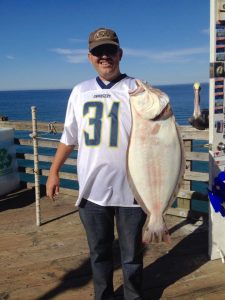
Halibut taken in 2016 (Picture courtesy of the Oceanside Pier Bait Shop)
As for rigging, use a Carolina-rig or another type of live bait rig, i.e., a short (24 inches or so) leader tied a couple of feet up above the sinker. Use a size 4 or 2 hook and a sinker just heavy enough to hold bottom. Lastly, hold your rod and reel, be ready for a strike and learn to feel both the bite and how to respond to the bite. Simply sitting your rod on the railing and waiting for a strike often leads to a missed strike.
Artificial lures can also be used for the halibut but realistically only when the pier isn’t too crowded. The favorite lures for years have generally been swim baits. i.e., a Big Hammer lure or something similar. However, the Lucky Craft Flash Minnow is increasingly being used (usually in grunion or smelt pattern). The halibut are found down in the depressions between the pilings. In response, anglers will walk the pier “trolling” their lures over those depressions. But as said, it’s hard to do if the pier is crowded.
One fish that has been showing up since the 1990s is lizardfish and at times they seem to cover the bottom from the inshore area almost to the end. Some years they are mostly small fish, 6-8 inches long while some years you may see some approaching a foot or more in length. They will hit almost any bait but usually are hooked on smaller hooks and it almost doesn’t matter what type of rigging is being used. Most people hate to see them and consider them a true trash fish but a few ethnic groups do eat them and some people say they make good halibut bait as long as you prevent them from burrowing into the sand. They seem to have up and down cycles with cold-water years seeing the most.
Although anglers seeking out croakers and perch often pack the inshore area, the end area is almost always crowded with anglers seeking out a wide variety of fish. When the mackerel are running, which can be often, the end area will see anglers shoulder to shoulder far into the night seeking out the speedsters.
Generally the mackerel (Pacific mackerel) will hit best on a small strip of squid or a bloody piece of mackerel and as a general rule the mackerel prefer to show up two times a day—early morning and early evening into the night. Many times I’ve seen anglers in the morning go fishless while nearby anglers who arrived an hour or so earlier had a full bucket of fish. Or, I see people leave the pier fishless while as soon as the sun drops the macks are in full attack mode. Nighttime fishing for the mackerel can be exciting. At night you’ll see various rigs, either people using bait or Sabiki-type bait rigs fished under a glow-stick (although 3-5 mackerel twisting up a Lucky Lura/Sabiki leader isn’t so lucky—it often results in the loss of the $2-3 leader). Often when the macs are hitting, glow sticks will be headed every which way and you will need to keep track of which line is yours so that it isn’t tangled with a neighbor’s line. It can be a little crazy at times but fun.
Bonito are considered a prize when they show up. The bonito, mostly in the 1-3 pound class but occasionally including some large 6-8 pound fish, generally hit during the day (especially at dawn) and prefer a splasher-type rig (a wooden ball, a cast-a-bubble, or a golf ball—with a green and white colored feather trailing behind it). However, spoons—Megabaits, Kastmasters, or Krocodiles have become increasingly popular for the boneheads.
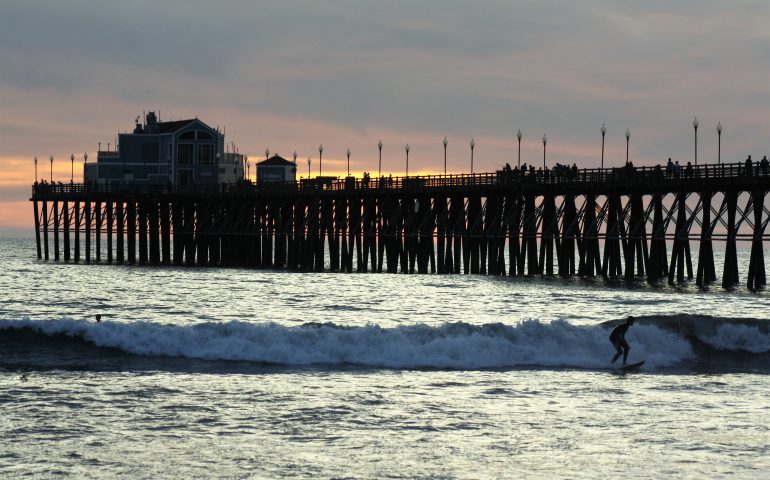
Always enjoy reading your articles Mr. Jones. I’ve been visiting Oceanside pier for close to 40
years, and enjoy your guide book for many years. Enjoyed some quiet fishing after midnight fishing
there– it’s too crowded at daytime! I had no idea that there was a proposal to close it down at night!
Yes, you’re right– it’s not a cheap place to visit anymore, but it’s still beautiful! Thank you very much,
and good fishing! With respects– Haik Goomroyan from Las Vegas.
Haik, Thank you for your kind comments. Ken